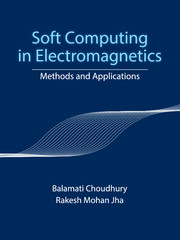Book contents
- Frontmatter
- Dedication
- Contents
- List of Figures
- List of Tables
- Preface
- Acknowledgments
- Abbreviations
- Symbols
- 1 Introduction
- 2 Soft Computing Techniques
- 3 Soft Computing in Electromagnetics: A Review
- 4 Bacterial Foraging Optimization For Metamaterial Antennas
- 5 PSO for Radar Absorbers
- 6 Characterization of Planar Transmission Lines Using ANN
- 7 Fault Detection in Antenna Arrays
- 8 Multi-Objective Particle Swarm Optimization for Active Terahertz Devices
- 9 Soft Computing based CAD Packages for EM Applications
- Author Index
- Subject Index
- References
5 - PSO for Radar Absorbers
Published online by Cambridge University Press: 05 July 2016
- Frontmatter
- Dedication
- Contents
- List of Figures
- List of Tables
- Preface
- Acknowledgments
- Abbreviations
- Symbols
- 1 Introduction
- 2 Soft Computing Techniques
- 3 Soft Computing in Electromagnetics: A Review
- 4 Bacterial Foraging Optimization For Metamaterial Antennas
- 5 PSO for Radar Absorbers
- 6 Characterization of Planar Transmission Lines Using ANN
- 7 Fault Detection in Antenna Arrays
- 8 Multi-Objective Particle Swarm Optimization for Active Terahertz Devices
- 9 Soft Computing based CAD Packages for EM Applications
- Author Index
- Subject Index
- References
Summary
As the name suggests, absorbers are devices that absorb electromagnetic radiation incident on them. Absorbers are hence used in applications where minimum reflection is desired such as construction of anechoic chambers, stealth aircraft, etc. Absorbers are also used to enhance the performance of detectors in various imaging systems like terahertz spectroscopy. Absorbers generally comprise of layers of different material placed one behind the other. Due to the nature of its construction, absorbers are extremely band specific. The selection of the material parameters and thickness of these layers determines the frequency and bandwidth of operation. This selection process is complex and time consuming as the designer must focus on the combination of material as well as its thickness simultaneously.
In this chapter, particle swarm optimization (PSO) is used to optimize the absorbers in a time efficient manner. First, the implementation of PSO for optimising conventional microwave absorbers is discussed. Following this, PSO based optimization of a metamaterial terahertz absorber for biomedical applications is presented.
Introduction
An electromagnetic absorber is a structure that ideally absorbs all the incident electromagnetic radiation without any transmission or reflection. This is achieved by selecting materials of specific dimensions. Often, designs employ the arrangement of multiple layers of varying dimensions in order to achieve maximum absorption. At the same time, applications in stealth technology imposes another constraint on the design namely that of thickness. These two design parameters conflict each other and the designer is forced to arrive at a trade-off between the two. As mentioned previously, this task is time-consuming. As a result, researchers have turned towards soft-computing in order to design optimized RAM structures.
Abundant literature is available for implementation of genetic algorithm and micro-genetic algorithm for RAM optimization. Chakravarty et al. [Chakravarty et al., 2001] used the same in order to design an FSS based broadband microwave absorber. The work also shows that implementation of micro-genetic algorithm over genetic algorithm considerably speeds up the computation time. The algorithm was designed to simultaneously select the best materials and their thicknesses as well as vary the structural parameters of the FSS for optimized performance.
A novel idea for the fabrication of ultrathin absorbers using electromagnetic band gap materials was presented by Kern et al. [Kern et al., 2003]. The technique involved replacing previously known FSS-resistive sheet designs with a lossy, high impedance FSS layer.
- Type
- Chapter
- Information
- Soft Computing in ElectromagneticsMethods and Applications, pp. 84 - 110Publisher: Cambridge University PressPrint publication year: 2016



